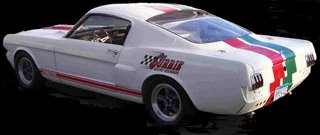
Freddy is complete and ready to race!
Join me in a daily blog that will capture the spirit and essence of La Carrera, one of the most unique and challenging road races in the world. Postings will begin on November 3rd as I make the 4000 mile trip south to Veracruz, Mexico, the starting point of La Carrera. Over the next 16 days I will pre-qualify for the race and finally make my way up to Monterrey during 7 days of hard racing.
Below is a overview of La Carrera printed from Gerie Bledsoe on his website www.panamrace.com. You can also check out the official website at: http://www.lacarrerapanamericana.com.mx/
We have few opportunities in our lives to experience a legend. La Carrera Panamericana or the “Pan Am” is one of those rare opportunities. It is the last open, top speed road race of its kind in the world. No one can predict how long it will survive in this modern age.
This November, 70 or more vintage race cars--each with a driver and co-driver--line up in southern Mexico to race nearly 2000 miles back to border with Texas. It’s seven full days of full-speed racing over paved roads, through some of the most beautiful countryside north of the Equator. Seven days of freedom. It’s a week of feeling very special and a lifetime of memories.
The modern race is a revival of the famous international Pan Am that was conducted between 1950-1954. Many of the world’s most famous drivers, including world champions like Phil Hill and Juan Manuel Fangio, came to Mexico during these years to test their cars, skill, and stamina. The race was started in 1950 by the Mexican government to inform the world that Mexico had a new system of highways that stretched across the country – from north to south – for commerce and tourism. When the race was canceled in 1955, its purpose had been accomplished.
In 1988 a group of Mexican and North American auto enthusiasts revived the Pan Am. The event operates in a “pro-rally” format. Each car is given a route book with detailed instructions to follow for the entire seven days. Every turn along the entire route is listed, and each is rated by degree of difficulty. Warnings are given about dangerous conditions, and even speed bumps and special attractions are noted. But there can always be a surprise lurking around each blind corner.
Each day is divided into “transit” and “special” stages. The transit stages are run from town to town on regular highways, in regular traffic. But several times a day the Pan Am cars line up for the special stages or speed sections. After the Mexican Federal Highway Patrol clears the road, the Pan Am cars are started in thirty-second intervals. There are no speed limits--only open roads slicing through the mountains. You may travel as fast as your skill, your car, and road conditions warrant.
These special sections normally stretch from three to sixteen miles in length, mostly over good, paved mountain roads. The stages may also be run on a sports car track or freeways. At the end of the week, the cars with the lowest elapsed times for the special stages are declared the winners – overall and by class. Time penalty points may be awarded if you arrive too early or too late to a speed section, or commit an infraction of the rules.
The Pan Am is a combination of serious racing and adventure. It is a true test of driving and mechanical skills, stamina, and patience. Most importantly, perhaps, it is an opportunity to see a beautiful country and meet its gracious people. You will cherish these memories and the friends you’ll make forever!


